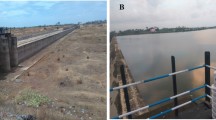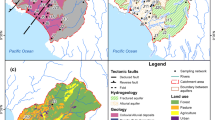Abstract
Algal blooms and fish kills were reported on a river in coastal Georgia (USA) downstream of a poultry-processing plant, prompting officials to conclude the problems resulted from overland flow associated with over-application of wastewater at the plant’s land application system (LAS). An investigation was undertaken to test the hypothesis that contaminated groundwater was also playing a significant role. Weekly samples were collected over a 12-month period along an 18 km reach of the river and key tributaries. Results showed elevated nitrogen concentrations in tributaries draining the plant and a tenfold increase in nitrate in the river between the tributary inputs. Because ammonia concentrations were low in this reach, it was concluded that nitrate was entering via groundwater discharge. Data from detailed river sampling and direct groundwater samples from springs and boreholes were used to isolate the entry point of the contaminant plume. Analysis showed two separate plumes, one associated with the plant’s unlined wastewater lagoon and another with its LAS spray fields. The continuous discharge of contaminated groundwater during summer low-flow conditions was found to have a more profound impact on river-water quality than periodic inputs by overland flow and tributary runoff.
Résumé
Des proliférations d’algues et des exterminations de poissons ont été signalées dans une rivière de la côte de Géorgie (USA) à l’aval d’une usine de conditionnement de volaille, ce qui a amené les autorités à conclure que les problèmes résultaient d’un écoulement d’origine terrestre associé à un apport d’eau usée excessif au niveau des champs d’épandage de l’usine (LAS).Une recherche a été entreprise dans le but de vérifier l’hypothèse que l’eau souterraine polluée jouait aussi un rôle significatif. Des prélèvements hebdomadaires ont été effectués pendant une période de 12 mois le long d’un tronçon de 18 km de la rivière et des principaux affluents. Les résultats ont montré des concentrations élevées en azote dans les affluents drainant l’usine et une augmentation d’un facteur dix des nitrates dans la rivière entre les apports des affluents. Parce que les concentrations en ammoniaque étaient basses sur ce tronçon, on a conclu que les nitrates étaient apportés par l’écoulement de la nappe. Des données provenant d’échantillonnage minutieux en rivière et d’échantillons ponctuels de sources et de forages ont été utilisées pour isoler le point d’entrée de la langue de pollution. L’analyse a mis en évidence deux langues séparées; l’une associée à la lagune d’eau usée non étanchée de l’usine et une autre à ses champs d’épandage LAS. On a trouvé que l’écoulement continu d’eau polluée de la nappe pendant les conditions estivales de basses eaux a un impact plus prononcé sur la qualité de l’eau de rivière que les apports périodiques d’écoulements d’origine terrestre et des affluents.
Resumen
La información de la floración de algas y de la mortandad de peces muertos en un río en las zonas costeras Georgia (EEUU), aguas abajo de una planta de procesamiento de aves de corral, impulsó a los funcionarios a concluir que los problemas eran el resultado del flujo superficial asociados con una sobre-aplicación de aguas residuales en el sistema de uso de la tierra de la planta. Se realizó una investigación para probar la hipótesis que las aguas subterráneas contaminadas también desempeñaban un papel significativo. Se colectaron muestras semanales durante un período de 12 meses a lo largo de un tramo de 18 km del río y de los afluentes principales. Los resultados mostraron concentraciones elevadas de nitrógeno en los afluentes que drenaban la planta y un aumento de 10 veces en los nitratos del río entre los puntos de ingreso de los afluentes. Debido a que las concentraciones de amoníaco fueron bajas en este tramo, se concluyó que el nitrato estaba entrando a través de la descarga de las aguas subterráneas. Se usaron datos de muestreos detallados del río y muestras directas de aguas subterráneas de manantiales y perforaciones para aislar el punto de entrada de la pluma de contaminantes. Los análisis mostraron dos plumas separadas, una asociada con las lagunas de aguas residuales no cubiertas de la planta y otro con los campos de aspersión del sistema de uso de la tierra. Se encontró que la continua descarga de agua subterránea contaminada en condiciones de flujos bajos durante el verano tenía un impacto más profundo en la calidad del agua del río que los ingresos periódicos del agua por flujo superficial y por escurrimiento de los afluentes.
摘要
在位于美国乔治亚州沿海地区某家禽加工厂下游的河流中发生藻华和鱼类死亡的现象见诸报道后, 政府断定问题系由与该厂土地处理系统 (LAS) 废水过量引起的坡面流所致。为了检验污染地下水是否也起到了重要作用, 我们进行了专门调查。每周对18 km长的河段及其重点支流进行取样, 为期12个月。结果显示, 排泄该处理厂尾水的支流中氮浓度升高, 两支流之间的河段硝酸根增加了十倍。由于该河段氨浓度较低, 故推断硝酸盐系通过地下水的排泄而进入河中。根据详细的河水取样和由泉、钻孔直接取得的地下水样数据, 找出了污染羽的源头。分析表明存在两个独立的污染羽, 一个与该厂无衬砌废水塘有关, 另一个与该厂LAS的喷雾场地有关。夏季径流量较小时污染地下水向河流的持续排泄对河流水质的影响要大于周期性的坡面流和支流的径流补给。
Resumo
Foram detectados fenómenos de explosão de algas e de morte de peixes num rio localizado na zona costeira da Geórgia, a jusante de uma fábrica de processamento de aves. Relatórios técnicos confirmaram que aqueles problemas resultaram de um escoamento superficial ou sub-superficial associado a uma sobre-aplicação de águas residuais envolvidas num sistema de aplicação desses resíduos no solo (plant’s land application system, LAS). De forma a estudar a hipótese de que aquela contaminação tenha também a sua origem em descargas de água subterrânea, foi efectuada uma investigação que consistiu na recolha de amostras semanais por um período de 12 meses ao longo dos 18 km do rio e dos seus afluentes. Os resultados das análises mostraram existir elevadas concentrações de compostos azotados nos rios tributários que drenam a área da fábrica e a decuplicação dos valores de nitrato no rio entre aqueles tributários. Porque as concentrações de amonia se revelaram baixas neste troço, concluiu-se que a origem da contaminação por nitrato provém de descarga de água subterrânea contaminada. Foi assim realizada uma amostragem detalhada no rio, em nascentes e em poços, com o objectivo de localizar o ponto de entrada da pluma de contaminação. A análise mostrou existirem duas plumas distintas, uma associada à lagoa das águas residuais da fábrica e outra associada com os dispositivos de dispersão de rega no campo (LAS). A descarga contínua de água subterrânea contaminada durante os períodos de caudal reduzido na época de Verão mostrou ter um maior impacte na qualidadae da água do rio do que as entradas periódicas de caudal superficial e sub-superficial arrastado dos terrenos agrícolas e do que escoamento proveniente dos tributários.











Similar content being viewed by others
References
Allen JD (1995) Stream ecology: structure and function of running waters. Chapman and Hall, London
Andersen LJ, Kristiansen H (1984) Nitrate in groundwater and surface water related to land use in the Karup Basin. Denmark Environ Geol 5:207–212
Caruso BS (2002) Temporal and spatial patterns of extreme low flows and effects on stream ecosystems in Otago, New Zealand. J Hydrol 257:115–133
Fenelon JM, Moore RC (1998) Transport of agrichemicals to ground and surface water in a small central Indiana watershed. J Environ Qual 27:884–894
Grayson RB, Gippel CJ, Finlayson BL, Hart BT (1997) Catchment-wide impacts on water quality: the use of “snapshot” sampling during stable flow. J Hydrol 199:121–134
Hayashi M, Rosenberry DO (2002) Effects of ground water exchange on the hydrology and ecology of surface water. Ground Water 40:309–316
Holmes RM (2000) The importance of ground water to stream ecosystem function. In: Jones JP, Mulholland PJ (eds) Streams and ground waters. Academic Press, San Diego, pp 137–148
Howarth RW, Sharpley A, Walker D (2005) Sources of nutrient pollution to coastal waters in the United States: implications for achieving coastal water quality goals. Estuaries 25:656–676
Hooda PS, Moynagh M, Svoboda IF, Thurlow M, Stewart M, Thomson M, Anderson HA (1997) Streamwater nitrate concentrations in six agricultural catchments in Scotland. Sci Total Environ 201:63–78
Israel DW, Showers WJ, Fountain M, Fountain J (2005) Nitrate movement in shallow ground water from swine-lagoon-effluent spray fields managed under current application regulations. J Environ Qual 34:1828–1842
Karr JD, Showers WJ, Gilliam JW, Andres AS (2001) Tracing nitrate transport and environmental impact from intensive swine farming using delta nitrogen-15. J Environ Qual 30:1163–1175
Kemp MJ, Dodds WK (2001) Spatial and temporal patterns of nitrogen concentrations in pristine and agriculturally-influenced prairie streams. Biogeochemistry 53:125–141
Krause RE, Randolph RB (1989) Hydrology of the Floridan Aquifer System in southeast Georgia and adjacent parts of Florida and South Carolina. US Geol Surv Prof Paper 1403-D, 65 pp
Mikkelsen RL (1995) Swine waste disposal: a case study. J Nat Resour Life Sci Educ 24:169–172
Nolan BT, Stoner JD (2000) Nutrients in groundwaters of the conterminous United States, 1992–1995. Environ Sci Technol 34:1156–1165
Nolan BT, Ruddy BC, Hitt KJ, Helsel DR (1997) Risk of nitrate in groundwaters of the United States: a national perspective. Environ Sci Technol 31:2229–2236
Pionke HB, Gburek WJ, Schnabel RR, Sharpley AN, Elwinger GF (1999) Seasonal flow, nutrient concentrations and loading patterns in stream flow draining an agricultural hill-land watershed. J Hydrol 220:62–73
Power G, Brown RS, Imhof JG (1999) Groundwater and fish: insights from northern North America. Hydrol Proc 13:401–422
Ritter WF, Harris JR (1984) Nonpoint source nitrogen loads to Delaware lakes and streams. Agric Wastes 9:35–50
Sallade YE, Sims JT (1994) Nitrate leaching in an Atlantic Coastal Plain soil amended with poultry manure or urea-ammonium nitrate: influence of thiosulfate. Water Air Soil Pollut 78:307–316
Sharpley AN (1997) Rainfall frequency and nitrogen and phosphorus runoff from soil amended with poultry litter. J Environ Qual 26:1127–1132
Sloan AJ, Gilliam JW, Parsons JE, Mikkelsen RL, Riley RC (1999) Ground water nitrate depletion in a swine-lagoon effluent-irrigated pasture and adjacent riparian area. J Soil Water Conserv 54:651–656
Spaulding RF, Exner ME (1993) Occurrence of nitrate in groundwater: a review. J Environ Qual 22:392–402
Spruill TB, Showers WJ, Howe SS (2002) Application of classification tree methods to identify nitrate sources in ground water. J Environ Qual 31:1538–1549
Tate KW, Dahlgren RA, Singer MJ, Allen-Diaz B (1999) Timing, frequency of sampling affect accuracy of water-quality monitoring. Calif Agric 53:44–48
Weil RR, Weismiller RA, Turner RS (1990) Nitrate contamination of groundwater under irrigated coastal plain soils. J Environ Qual 19:441–448
Acknowledgements
The authors would like to thank the Associate Editor and two anonymous reviewers for their critical review of the manuscript. Thanks are also extended to the Managing Editor, Professor Craig Simmons, who welcomed and encouraged the new focus of this report.
Author information
Authors and Affiliations
Corresponding author
Rights and permissions
About this article
Cite this article
Reichard, J.S., Brown, C.M. Detecting groundwater contamination of a river in Georgia, USA using baseflow sampling. Hydrogeol J 17, 735–747 (2009). https://doi.org/10.1007/s10040-008-0382-2
Received:
Accepted:
Published:
Issue Date:
DOI: https://doi.org/10.1007/s10040-008-0382-2




